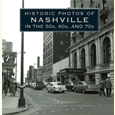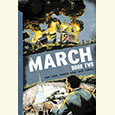Floating in Memphis
Patrick O’Daniel records the Bluff City’s greatest disaster
In Memphis and the Superflood of 1937: High Water Blues, librarian Patrick O’Daniel has written a compact volume detailing of one of the worst floods in American history. In early 1937, the Ohio and Mississippi valleys were deluged with rain and snow, creating a disaster so far beyond anyone’s previous experience that the rules of flood control and disaster response had to be rewritten in the aftermath.
By the late 1930s, Memphis prided itself on being a new Southern city, full of industry and culture. The city had suffered several large floods—most recently in 1927—and had a system of levees in place to control what was thought to be a worst-case inundation. But in the first month of 1937, record rainfall across the middle of the country produced a rolling wave of water that washed down the Ohio and Mississippi rivers, displacing hundreds of thousands of people. Tens of thousands headed for Memphis, where city officials, led behind the scenes by political boss Edward Crump, did their best to help. Soon, every element of the city, from prisoners to the mayor, was engaged in preparing for the worst. They knew the flood was headed toward them. As O’Daniel writes, “The stunned officials could hardly believe what they heard. The flood stage would exceed the flood of 1927 by 9.5 feet, far more than what any levee could withstand.”
 When it crested in February, the Mississippi River was over three miles wide at Memphis, but thanks to cooperation among federal, state, and local officials and volunteers from every walk of life, catastrophe was avoided. To be sure, there were serious problems, and some inexcusable behavior—including the shanghaiing of black Memphians to work the levees at pay rates much lower than their white counterparts—but O’Daniel notes that the response prevented large outbreaks of disease or loss of life and provided record numbers of refugees with food and shelter. Indeed, it’s impossible not to wonder how today’s bureaucracy would perform in a similar situation.
When it crested in February, the Mississippi River was over three miles wide at Memphis, but thanks to cooperation among federal, state, and local officials and volunteers from every walk of life, catastrophe was avoided. To be sure, there were serious problems, and some inexcusable behavior—including the shanghaiing of black Memphians to work the levees at pay rates much lower than their white counterparts—but O’Daniel notes that the response prevented large outbreaks of disease or loss of life and provided record numbers of refugees with food and shelter. Indeed, it’s impossible not to wonder how today’s bureaucracy would perform in a similar situation.
The disaster affected the nation’s politics, economy, and culture—even a young Johnny Cash was inspired by its magnitude—and put Memphis at the center of the action. “The events of 1937,” notes O’Daniel, “not only mark a turning point in flood control but also illustrate the importance of Memphis regionally and nationally.” Though sometimes lost against the backdrop of the Great Depression and World War II, the superflood of 1937 carries lessons no less important to residents of today’s mid-South.
Patrick O’Daniel will discuss the story at Davis-Kidd Booksellers in Memphis on October 16 at 1 p.m.


